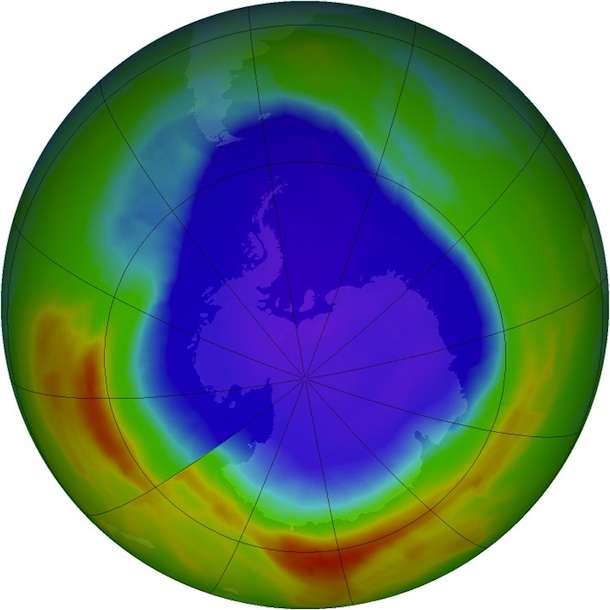The view of the Red Sea was spectacular, but it was all work and no play for NASA atmospheric scientist Paul Newman during a recent trip to Port Ghalib, Egypt. That’s where scientists, policymakers, and representatives of the United Nations Environment Programme, convened Nov. 4-8 for an annual meeting to discuss and amend the Montreal Protocol — the international agreement that regulates ozone-depleting substances. Newman attended as co-chair of the Scientific Assessment Panel and gave us an inside look.
Q: Scientists use satellites and computer models to better understand the recovery of the ozone layer. How does this kind of science contribute to the policy decisions?
A: The Montreal Protocol regulates gases that destroy ozone, also known as ozone depleting substances (ODSs). The most famous of these are the chlorofluorocarbons (CFCs) that were used in spray cans and as refrigerants. Science provides that foundation for the Protocol. We used (and still use) models to predict the evolution of ozone in our atmosphere in response to the regulations made by the signatory countries. Satellite, aircraft, balloon, and ground observations provide a check on our model estimates. If you can’t simulate the past, it’s hard to claim that you can predict the future.
Q: What is involved in a typical day as “co-chair of the scientific assessment panel”?
A: We’re commonly referred to as the SAP. Not a great acronym for the scientists! In any case, we are the “on-the-spot” science advisors on all policy questions.
In a typical day, there is a lot of discussion amongst the delegates about technical issues. Delegates actively discuss “critical use exemptions.” For example, methyl bromide is used as a fumigant. Plants, flowers, vegetables are all fumigated to help preserve them or to stop the spread of invasive species such as fruit flies. Without some sort of fumigation, entire farming industries might be destroyed. However, methyl bromide is also an ozone depleting substance. The SAP provides information on methyl bromide as an ozone depleting substance. For example, if we stop all methyl bromide usage, how much will this help the ozone layer?
Q: Why is there the need to revisit the Montreal Protocol with regular meetings?
A: The Protocol was designed to be an evolving agreement. Originally, the production of ODSs was limited, not stopped. Over the years, policymakers strengthened the original agreement such that all CFC production is now stopped. However, there is still some usage in developing countries, and there are stocks of ODSs that could potentially be destroyed. The nations get together twice per year to talk over the needs for evolving or strengthening the agreement.
Q: What are hydrofluorocarbons (HFC’s), and why do you think a proposal to include HFCs in the protocol was unsuccessful this year?
A: Hydrofluorocarbons, or HFCs, are used as refrigerants, and they don’t destroy ozone. However, HFCs are powerful greenhouse gases.
When CFCs were banned, alternative refrigerants were developed to take their place. The initial alternatives were hydrochlorofluorocarbons (HCFCs). HCFCs were still ozone depleting substances, but they had much shorter lifetimes than CFCs, and hence, were less ozone dangerous than CFCs. In 2007, the HCFCs were banned under the Montreal Protocol and are now being phased out.
HCFCs are now being replaced by HFCs. The Montreal Protocol shifted from the ozone dangerous CFCs to the less dangerous HCFCs, and now to the ozone safe HFCs. By banning CFCs, the Montreal Protocol had a double benefit: less ozone depletion and less greenhouse gas warming (CFCs are powerful greenhouse gases).
However, by banning CFCs, the Montreal Protocol created a demand for the ozone-safe HFCs (people still want air conditioners). All of the climate benefit gained by banning CFCs might be lost as HFCs increase in our atmosphere. Hence, some people are calling for the banning of HFCs under the Montreal Protocol, in spite of the fact that HFCs don’t destroy ozone. By banning HFCs, the Montreal Protocol would become both an ozone treaty and a climate treaty.
The HFC amendment did not go through for a number of reasons. The primary reason is that many countries believe that HFCs are climate related and should therefore be regulated under the Kyoto Agreement.
Q: What current research do you think could impact future meetings?
A: The Montreal Protocol is evolving into both an ozone and climate agreement. It is still necessary for scientists to investigate the impact of human-produced chemicals on both ozone and climate. Every day new chemicals are being proposed for various uses, and the scientists need to assess the environmental impact to select those chemicals that are non-toxic and environmentally safe.
–Kathryn Hansen, NASA’s Earth Science News Team




